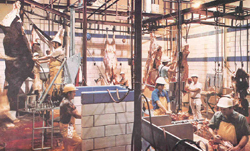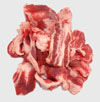Meats and Sausages
Meat Classes
Imagine a butcher cutting pork into smaller meat pieces until nothing is left on the table. Before he can carve out a ham from the leg, he has to separate it from the body, cut off the lower leg, and remove the bones, tendons, gristles, sinews, skin, pieces of fat, etc. To get a clean piece of meat like a ham, butt, or pork loin, a lot of work has to be performed first that leaves scraps of meat which can not be sold in one piece. Keep in mind that the meat plant was established to bring profits to its owners, and every little piece of meat, fat, and blood included is money.
A commercial recipe does not call for pork butt, lean ham, or beef chuck. The recipe asks for pork class 1, beef class 2, or back fat class 1 or 2. It may call for jowl or bacon fat. It does not matter whether this meat comes from ham, butt, picnic, or a container with little meat pieces as long as it fulfills the requirements of the recipe. Only after all those meat scraps are depleted can a meat plant resort use noble parts such as ham or loin for sausages. All those trimmings end up in a cooler in labeled containers. Names such as ham, picnic, or butt lose their meaning as one can only see cuts of meat with different fat contents. They must be classified logically so any operator can pick them up from a cooler and transfer them to production.
Professional butchers carving meat. The same can be accomplished at home, as shown in the following photos.
All Polish sausage recipes call for meat that belongs to a specified class: I, II, III, or IV. When making a few pounds of sausage, we can use names like ham, butt, or picnic, but when a meat plant makes thousands of pounds of sausages a day, a different system is employed. It takes a lot of knife carving to obtain meat cuts like loins, slabs of bacon, butts, hams, or ribs, and a butcher segregates the remaining scraps of meat into corresponding piles called classes.
Understanding meat classes will help you shop for better deals at a local store. Instead of studying a label in detail, you will study the meat cut itself to see what quality or meat class it represents. When trimming pork chops, loins, or ribs for roasting, save all those remaining meat pieces by placing them in a freezer. They will make fine sausages at a later date. When trimming pork butt, save the skin and fat for later use in a head cheese or liver sausage.
Pork Class II
Looking at meat class III, which contains a lot of sinews, one can feel that it is a poor scrap. After all, who wants to chew meat with sinews? The truth is that this is an important meat class as it contains a lot of collagen, which is necessary for creating gelatin and binding meats together when making head cheeses or liver sausages. It also binds water very well, making products juicier.
Knowing meat classes will help you immensely when shopping for better supermarket deals. You will see what quality meat you buy regardless of what’s on the label. Next time, when trimming pork chops, loins, or hams for roasting, save all those little meat pieces and put them into a freezer. You can use them to make sausages at a later date. Or when making sausages from pork butt, save the skin and fat for later use in a head cheese or liver sausage. When carving ham or butt, you will get all meat classes, of course, in different proportions. The picnic (pig's front shoulder), mainly for class III, will also provide class II or a piece of meat for class I. It is a good substitute for pork head meat. You have to use your judgment; for example, trimmed pork loin is a very lean cut of meat and class I. It is also expensive, and most of us would not use it to make sausage.
Pork Fat
There are different types of fat, and they will all be used but for different purposes. Hard, medium, and soft fats have different textures and melting points. There is bacon fat, back fat, dewlap fat, jowl fat, kidney and casings fat, and so on. Some head cheese and emulsified sausage recipes call for jowl fat that may be hard to obtain. The photos show that the belly may be a good replacement, but it is not. Bacon is a soft belly fat, and dewlap/jowl is a hard fat. Fatter cuts from a pork butt are a much better choice that contains hard fat and meat (class IIB).
Beef Meat Classes
There are seven USDA Beef Grades: Prime, Choice, Select, Standard, Commercial and Utility, Non-graded beef, and Natural beef. In addition, there are thirteen major steak names and several beef roasts. From a sausage-making point of view, all that is needed is the table that follows below:
Beef fat is a poor choice as it is yellow and does not taste good. People who refrain from eating pork because of religion can choose beef or sheep fat or add some vegetable oil.













































